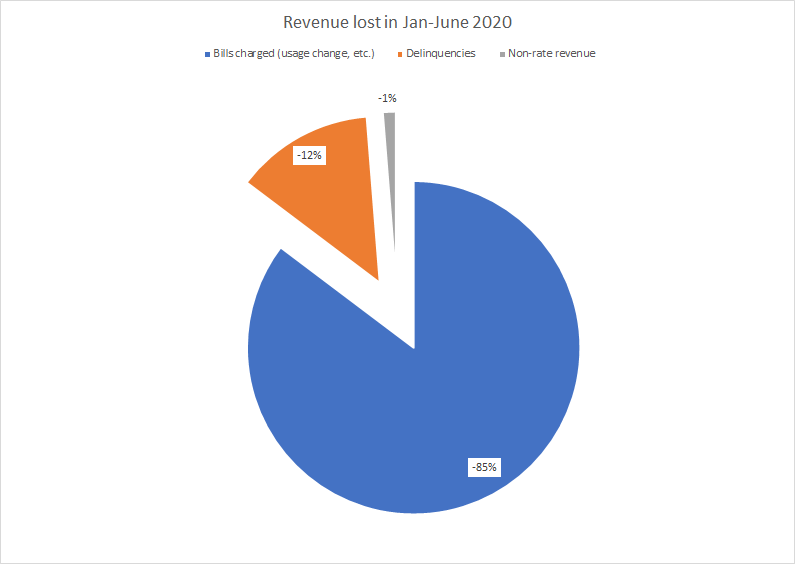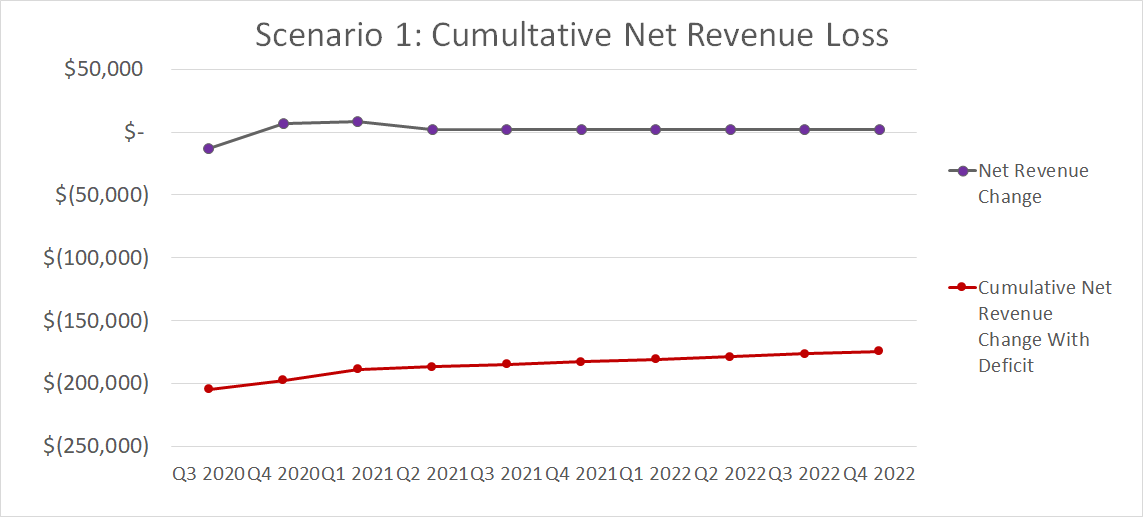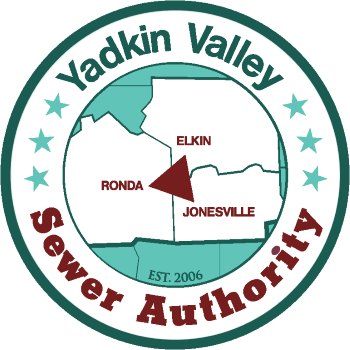The abrupt arrival of COVID-19 in the United States financially impacted businesses across all sectors, with water and wastewater utilities being no exception (see our previous blog post). Two major factors influenced revenue streams for utilities in the state. The first was Executive Order 124/142 issued by Governor Cooper on March 31st, which prevented utilities from disconnecting water or wastewater services to residential customers due to missed payments. This moratorium extended until the end of July. The second factor was that many commercial, industrial, and institutional customers reduced or stopped their operations in line with the statewide stay-at-home order. For some communities, non-residential customers use the greatest share of water or wastewater. The utilities in these areas were at risk of significant revenue declines due to these customers ceasing operations.
We know there are a wide range of financial impacts on utilities during the pandemic depending on the size and composition of each utility’s customer base. By diving deep into a case study of one utility, we can better understand the specific effects that some systems across the state have been experiencing. At the EFC, we’ve been working with the Yadkin Valley Sewer Authority (YVSA) since the beginning of the pandemic to assess their financial condition and provide technical assistance. Using data and interviews they’ve provided, we are able to share a case study of their experience over the past year and how they are preparing for the future.
YVSA Before COVID-19
YVSA provides sewer service to three towns in North Carolina: Elkin, Jonesville, and Ronda, joining the three towns from three different counties on a single sewer system. Established in 2006, the Authority operates under one joint discharge permit. The three towns each collect payments from customers and in turn directly pay YVSA. The towns send the payments in a lump sum without showing the amounts from individual customers. Because of this process, YVSA cannot tell how many delinquencies each town has. Instead, the Authority estimates the charges versus the actual money collected from each town by looking at information that the towns provide.
In late 2019, YVSA saw a change in usage from its top billing customer. A manufacturing company had made a transition from a 7-day to a 5-day work week. This caused the company, which contributed to 25% of YVSA’s annual revenue, to cut down their wastewater usage to about 80% of its average 2019 levels. In terms of financial impact, this translated to an estimated 5% annual operating revenue loss for YVSA. At the beginning of 2020 and thus before pandemic impacts, the manufacturing plant had already slowed down its production and thus YVSA’s revenue was already being impacted.
COVID-19 Impacts
In mid-March, the manufacturing plant slowed down its operations and as a result its wastewater usage decreased to approximately 70% of its prior 2019 usage. After the first stay-at-home order was announced, the plant completely shut down its operations, along with many other businesses in the Yadkin Valley jurisdiction. From April to June, YVSA saw on average a 30% decrease in non-residential wastewater usage compared to the monthly 2019 levels. YVSA anticipated that residential wastewater usage would increase during this time period, as residents would be spending more time in their homes instead of at work. On the contrary, YVSA saw minimal change, leaving the utility with a net decrease in revenue. In total, the loss of this manufacturing plant’s revenue amongst other commercial customers contributed to 85% of the YVSA’s revenue loss from January to June 2020.
On March 31, 2020, Governor Cooper rolled out Executive Order 124/142, prohibiting utilities from disconnecting residential customers who were unable to pay for water/wastewater services during the COVID-19 pandemic. In contrast to the impacts from non-residential usage, estimated delinquencies accounted for 12% of the total revenue lost from January to June. Under EO 124/142, utilities were not allowed to charge penalties for late payments, connections or tap fees, resulting in a loss of non-rate revenue for YVSA as well. However, this loss can be considered almost negligible, accounting for an estimated 1% of total revenue lost.

Revenue Budget Changes
Because of YVSA’s budget adjustments, it seems that the utility is ready to weather the consequences of COVID-19 for some time. Back in June, YVSA presented the case for a base and volumetric rate increase (50 cents each) to the board, which issued an approval, actually going up 75 cents on the volumetric rate. One board member, a medical doctor, approved the rate increases with a strong interest, publicly noting that greater rates are necessary to help utilities protect public health. Having a commissioner who understands the benefits of wastewater infrastructure and supports changes can be a benefit to a utility, allowing them to not only conduct a rate structure review to ensure that rates are high enough to treat the water properly, but also ensuring that the utility is financially sustainable going forward.
The figures below show the estimated losses suffered in the 3rd calendar quarter of 2020, that can be offset by the rate increases and payments on delinquencies. By Q4 of 2020, YVSA could be seeing a gain in monthly net revenue compared to 2019. They will, however, likely be working to make up for the deficit suffered from January to June 2020 for several years to come.

Estimated net revenue loss includes the delinquent payments, the decrease in non-rate revenue, plus monthly payments on delinquents. For YVSA, Scenario 1 has EO 142 lifted on July 31st and businesses returning to normal operations.

Estimated cumulative net revenue loss adds up the net revenue loss suffered each month, tracking the total loss of revenue due to COVID-19 until Q4 2022. It includes the deficit suffered from January to June of 2020.
Expenses Budget
While the rate increases are projected to assist YVSA in recovering from its revenue loss, the impact of the pandemic has caused the utility to rethink its expenses budget. Operational staff is now working on a split-team schedule, which results in savings of approximately $300-$500 per week from reduced overtime hours. Staffers are split into Teams A and B and are receiving 40 hours of pay per week, regardless of how many hours they work. The transition to this new schedule and adjustment to budget cuts was made smoother by the positive workplace culture cultivated at YVSA. The utility is considering an eventual return to one full-time crew, as they find themselves behind on several maintenance issues, including clearing, mowing, and maintaining valves on pump stations. A return to a 40-hour work week is additionally dependent on whether or not another outbreak occurs in the Yadkin Valley area, with concern about the spread of the virus impacting not only the revenue stream of the utility, but also the health and safety of the employees.
Back in March, YVSA was in the midst of two capital projects. Improvements were needed for a pump station, a collection system, and a wastewater treatment plant. These projects were funded from grants and loans, meaning they did not have to be put on pause during the pandemic. However, YVSA decided to slow capital expenditures to save funds. They aren’t doing any outfall clearing for the foreseeable future, and many line items have been cut. Budget amendments, including the elimination of overtime hours and reduction of capital outlay, accounted for approximately $160,000 in savings.
As of early August, YVSA has seen wastewater flows return to normal levels. The manufacturing plant is operating at 80-90% of what they would consider full capacity. Although wastewater usage is back at normal levels, the experience with COVID-19 has impacted the utility’s long-term financial planning. A tight budget was prepared for FY2021, and they plan to supplement unrestricted cash reserves whenever possible. The budget is further restricted because the utility is unaware of what the delinquencies (and payment plans) look like at this point in time.
YVSA was able to weather the storm and increase future revenues by implementing fiscally responsible practices, showing that even in these uncertain times, it is possible for utilities to take steps to ensure financial stability.
Key Takeaways for Other Utilities
- Be aware of usage levels: Utilities should monitor usage levels and compare usage to previous years. For YVSA, the pandemic had a major impact on non-residential customers, who individually contribute more to usage than residential homes. With an increased risk of businesses shutting down due to either state-issued moratoriums or forced financial closure, utilities with a large non-residential customer base should be aware of potential effects on their revenue stream.
- Rate changes help compensate for losses: YVSA increased their rates to match the losses endured over 2020 and to ensure the necessary improvements to their wastewater infrastructure could be made.
- Wastewater infrastructure should be a public health concern: For YVSA, having a board member who was interested in wastewater and public health on the utility board was an asset. The medical doctor on YVSA’s board helped strengthen the argument for a rate increase, citing their knowledge on the benefits that high quality wastewater infrastructure provides to public health. Medical and public health professionals should be included as stakeholders whenever there is a decision-making process being conducted by utility boards.
- Examine expenses when possible: In the case of emergency situations that can significantly impact revenue, it is important to have a plan in place to reduce expenses wherever possible. At YVSA, the utility was able to save money by shifting worker schedules and phasing out contract work. Preparing for disaster scenarios involves taking a hard look at utility expenses while ensuring that quality service is still provided.
- Utilities can seek assistance: The EFC has a library of tools offered to help utilities assess their financial situations. The COVID-19 Revenue Change Tool allows utilities to evaluate how much revenue they have lost and are projected to lose due to COVID-19 conditions. Email Elsemarie Mullins for technical assistance.
Omid Barr is a Master’s student in the Gillings School of Public Health concentrating in Environmental Health Solutions. He received his B.S. from the University of Maryland in 2018. At the EFC, Omid is evaluating the potential for communities to raise more revenue from utilities in a way that is equitable and provides resiliency and protection from water-related disasters. He is also examining the revenue resiliency of utilities in the face of the COVID-19 crisis.





0 Comments
1 Pingback